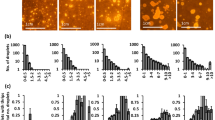Abstract
A simple, inexpensive chamber was developed and tested as an evaluative tool to monitor Trichogramma cordubensis dispersal in the laboratory. The chamber consisted of a continuous, winding channel which was cut into an aluminum block. Wasps were released at one end of the channel and allowed to walk in the channel for 21 h and to parasitize Mamestra brassicae eggs placed 3.4 m from the point of wasp introduction. Comparisons between two T. cordubensis populations demonstrated that one population (TCM) dispersed more in the chamber and located host eggs more successfully than the other population (TCD). Subsequent greenhouse releases confirmed that the TCM population dispersed more readily and had significantly higher parasitism rates on sentinel Ephestia kuehniella eggs on tomato plants. The potential utilization of this chamber as a tool to evaluate quality of Trichogramma populations, mainly dispersal activity, is discussed.
Similar content being viewed by others
References
Bigler, F., M. Bieri, A. Fritschy and K. Seidel, 1988. Variation in locomotion between laboratory strains of Trichogramma maidis and its impact on parasitism of eggs of Ostrinia nubilalis in the field. Entomol. Exp. Appl. 49: 283-290.
Bigler, F., 1994. Quality control in Trichogramma production. In: E. Wajnberg and S.A. Hassan (eds), Biological Control with Egg Parasitoids. CAB International, Wallingford, U.K. pp. 93-111.
Boldt, P.E., 1974. Temperature, humidity and host: effect on rate of search of Trichogramma evanescens and T. minutum auctt. (not Riley, 1871). Ann. Entomol. Soc. Am. 67: 706-708.
Cerutti, F. and F. Bigler, 1995. Quality assessment of Trichogramma brassicae in the laboratory. Entomol. Exp. Appl. 75: 19-26.
Collett, D., 1991. Modelling Binary Data. Chapman & Hall, London, UK.
Dutton, A., F. Cerutti and F. Bigler, 1996. Quality and environmental factors affecting Trichogramma brassicae efficiency under field conditions. Entomol. Exp. Appl. 81: 71-79.
Forsse, E., S.M. Smith and R.S. Bourchier, 1992. Flight initiation in the egg parasitoid Trichogramma minutum: effect of ambient temperature, mates, food, and host eggs. Entomol. Exp. Appl. 62: 147-154.
Greenberg, S.M., 1991. Evaluation techniques for Trichogramma quality. In: F. Bigler (ed), Proceedings 5th IOBC Workshop on Quality Control of Mass Reared Arthropods, 25–28 March 1991, IOBC, Wageningen, The Netherlands. pp. 138-145.
Hassan, S.A., 1989. Selection of suitable Trichogramma strains to control the codling moth Cydia pomonella and the summer fruit tortrix moth Adoxophyes orana (Lep., Tortricidae). Entomophaga 34: 19-27.
Hassan, S.A., 1994. Strategies to select Trichogramma species for use in biological control. In: E. Wajnberg and S.A. Hassan (eds), Biological Control with Egg Parasitoids. CAB International, Wallingford, U.K. pp. 55-72.
Hassan, S.A. and M.F. Guo, 1991. Selection of effective strains of egg parasites of the genus Trichogramma (Hym.,Trichogrammatidae) to control the European corn borer Ostrinia nubilalis Hb. (Lep., Pyralidae). Z. Angew. Entomol. 111: 335-341.
Kaiser, L. M.H. Pham-Delegue, E. Bakchine amd C. Masson, 1989. Olfactory responses of Trichogramma maidis: effects of chemical cues and behavioural plasticity. J. Insect Behav. 2: 701-712.
Kot, J., 1968. Factors affecting the efficiency of Trichogramma introduction. Proceedings of the XIII International Congress of Entomology 2: 155-158.
Laing, J.E. and F. Bigler, 1991. Quality control of mass produced Trichogramma species. In: F. Bigler (ed), Proceedings 5th IOBC Workshop on Quality Control of Mass Reared Arthropods, 25–28 March 1991, IOBC, Wageningen, The Netherlands. pp. 111-118.
Lenteren, J.C., van, 1986. Evaluation, mass production, quality control and release of entomophagous insects. In: J.M. Franz (ed), Biological Plantand Health Protection, Fischer, Stuttgart. pp. 31-56.
Li, L-Y., 1994. Worldwide use of Trichogramma for biological control on different crops: a survey. In: E. Wajnberg and S.A. Hassan (eds), Biological Control with Egg Parasitoids. CAB International, Wallingford, U.K. pp. 37-54.
Noldus, L.P.J.J., 1989. Chemical espionage by parasitic wasps. How Trichogramma species exploit moth sex pheromone systems. PhD dissertation, Wageningen Agricultural University, The Netherlands. 252 pp.
Noldus, L.P.J.J., J.C. Van Lenteren and W.J. Lewis, 1991. How Trichogramma parasitoids use moth sex pheromones as kairomones: orientation behaviour in a wind tunnel. Physiol. Entomol. 16(3): 313-327.
Pak, G.A., 1988. Selection of Trichogramma for inundative biological control. PhD dissertation, Wageningen Agricultural University, The Netherlands. 224 pp.
Smith, S.M., 1996. Biological control with Trichogramma: advances, successes, and potential of their use. Annu. Rev. Entomol. 41: 375-406.
Steenburgh, W.E. van, 1934. Trichogramma minutum Riley as a parasite of the oriental fruit moth (Laspeyresia molesta Busck.) in Ontario. Can. J. Res. 10: 287-314.
Suverkropp, B., 1997. Host-finding behaviour of Trichogramma brassicae in maize. PhD dissertation, Wageningen Agricultural University, The Netherlands. 249 pp.
Vereijssen, J., I. Silva, J. Honda and R. Stouthamer, 1997. Development of a method to predict the biological control quality of Trichogramma strains. Proceedings of the Section Experimental and Applied Entomology of the Netherlands Entomological Society (N.E.V) 88: 145-149.
Wührer, B. and S.A. Hassan, 1993. Selection of effective species/strains of Trichogramma (Hym., Trichogrammatidae) to control the diamondback moth Plutella xylostella L. (Lep., Plutellidae). Z. Angew. Entomol. 116: 80-89.
Author information
Authors and Affiliations
Rights and permissions
About this article
Cite this article
Honda, J.Y., Silva, I.M., Vereijssen, J. et al. Laboratory bioassay and greenhouse evaluation of Trichogramma cordubensis strains from Portugal. BioControl 44, 1–11 (1999). https://doi.org/10.1023/A:1009985806745
Issue Date:
DOI: https://doi.org/10.1023/A:1009985806745




